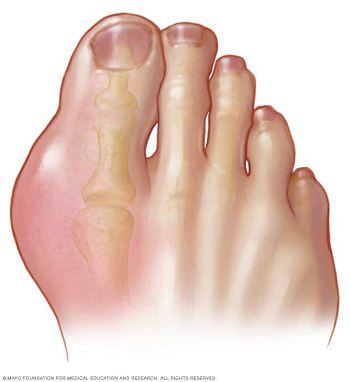
Gout (the disease of kings)
Sara Thamer Hadi
Disease definition:
• It is a rheumatic disease resulting from the deposition of uric acid crystals in tissues and fluids inside the body (articular fluid), which affects the smooth movement of joints, and often affects the big toe, and gout is characterized by acute and sudden attacks of pain in the joints, with swelling, redness, joint irritation and inflammation. . Gout is also one of the most common types of arthritis that affects men, as the incidence of gout is higher than women even when they reach menopause.
• An increase in uric acid in the blood can be defined if the uric concentration exceeds 6.5 mg / deciliter (mcmol / L385).
• It is considered clinically significant if the concentration exceeds 6.8 mg/dL.
• Where the therapeutic goal is considered to be less than (6 mg/dL) 355 mcmol/L.
Types of gout:
1- Gouty arthritis. 2- Chronic gallstones. 3- Gout associated with lead poisoning.
Risk factors for gout:
• Obesity, being overweight, and high blood pressure are strong factors. • Excessive drinking of alcohol. • High levels of sugar Consumption of sweetened soft drinks. • High levels of fructose consumption. • High levels of meat consumption • High levels of seafood consumption • Low levels of dairy consumption.
Causes of gout:
Some foods can cause gout, such as increased consumption of meat and mushrooms. • Usually uric acid dissolves in the blood and passes through the kidneys in the urine, but sometimes either the body produces too much uric acid or the kidneys excrete too little uric acid. When this happens, uric acid can build up and form urate crystals in surrounding tissues that cause pain, inflammation and swelling.
Symptoms of gout:
Gout causes sudden sharp pain, usually at the base of the big toe (the big toe joint), but it may affect any other joint, especially joints damaged by other conditions such as osteoarthritis. • Gout can affect the earlobe and the skin surrounding the joint, especially the joints of the fingers or the back of the heel.
Does gout affect the patient's life? It is possible to easily coexist with gout through regular daily drug treatment, diet and some exercise. It is preferable to follow the following instructions to coexist with gout: 1- Eating healthy food. 2- Staying away from stress. 3- Reducing excess weight. 4- Follow Doctor's instructions and health instructions. 5- Quit smoking, abstain from drinking alcohol. 6- Drink enough fluids at a rate of 6 cups per day.
Nutritional advice and guidance for a gout patient: Some foods and drinks may cause the body to produce too much uric acid. To keep uric acid at the normal level, the patient must reduce eating some foods and drinks such as: coffee, cocoa, seafood, spinach. Animal proteins such as red meat, liver, kidney, heart and alcohol should also be reduced. It is worth noting that Ramadan fasting for a gout patient is like an open clinic for treatment because fasting activates the metabolic cycle, which means the sum of the vital processes that occur inside the body to ensure its growth and proper functioning.
Sports and its importance for a gout patient: Gout damages the joints and makes them less mobile. This inactivity in turn makes you less flexible, weakens muscles and joints, and can lead to bone loss.
After controlling the acute attack of gout and bringing the disease under control, the patient can do exercises that help strengthen joints and muscles and also help the patient maintain an ideal weight.
